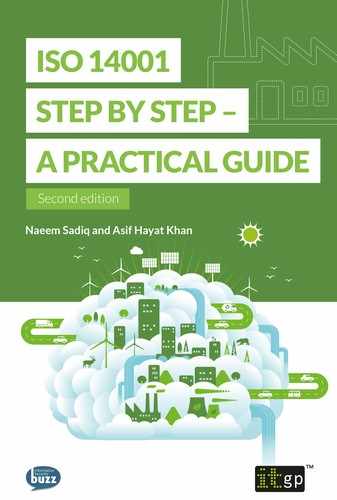CHAPTER 4: RESOURCES, ROLES, RESPONSIBILITY, AUTHORITY AND COMMUNICATION (CLAUSES 5.3, 7.1 AND 7.4)
Summary of requirements
• Provide sufficient resources to establish, implement, maintain and improve the EMS.
• Define and assign roles and responsibilities, and appoint specific management representative(s) for the EMS.
• Establish procedure(s) that define processes for internal and external communication.
How can these requirements be met?
An EMS system cannot be implemented or improved unless management provides the necessary human, financial, material, specialised skills and organisational resources. This may be done in the following manner:
1. Senior management defines the organisation’s structure, and the roles, responsibilities and authorities of all those who are required to perform any task relating to EMS. These could be tasks relating to identifying significant environmental aspects; establishing EMS objectives; ensuring the application of EMS controls; planning, measuring and monitoring EMS performance; training; communicating with internal and external bodies; ensuring compliance; and so on.
2. The next step is to ensure that the individuals have the skills and resources to perform their assigned roles. (See Chapter 5 for competency requirements.)
3. Top management must nominate a competent person as a ‘management representative’. They must have the authority to ensure that the EMS is established, implemented and maintained according to the requirements of ISO 14001. They must also report the performance of the EMS to top management for review and further improvement. (See Chapter 12 on elements that constitute this report.) Some aspects of a management representative’s competence could include knowledge of environmental issues, ISO 14001, environmental controls and good communication skills.
Communication
To implement an effective EMS, an organisation must communicate internally as well as externally.
Internal communication
This focuses on communication within the organisation and could entail:
• Awareness of and training on all EMS issues, requirements and procedures at various levels within the organisation;
• Communicating applicable requirements to all concerned;
• Receiving feedback on the measuring and monitoring of the EMS’s performance;
• Communicating the results of the EMS’s performance to top management;
• Ensuring that people at all levels and in all functions receive the needed EMS information in a reasonable timeframe; and
• Ensuring that employees are able to forward suggestions and EMS concerns to the relevant management.
The following list provides examples of internal communication:
• Bulletin board displays about the key EMS goals and the extent to which they have been achieved.
• Regular EMS meetings, at various levels of management and for various levels of employees to discuss and review EMS issues.
• Training and awareness sessions.
• Reporting EMS performance to top management.
• Emails and notes in salary slips informing employees about EMS initiatives.
• Suggestion boxes.
• Newsletters.
External communication
An organisation may need to communicate with external stakeholders. These could be customers, vendors, suppliers, contractors, neighbours, environmental groups and regulators.
External communication could entail:
• Receiving and responding to concerns of interested parties, such as NGOs, environmental groups and communities;
• Communicating with regulatory and environmental protection agencies; and/or
• Communications relating to permits, licences and fines.
A sample communication procedure can be found in Appendix B.
The organisation must choose whether it wishes to communicate externally about its significant environmental aspects. If it decides to do so, it must define who will communicate, to whom they will communicate and how this communication will take place.
Examples of external communication:
• Maintaining a website that describes the organisation’s EMS policy and initiatives.
• Meetings with vendors and suppliers to explore options for environmentally friendly products.
• Informing customers about the organisation’s EMS initiatives and encouraging them to do the same.
• Participating in community meetings.
• Receiving and responding to government and regulatory agencies.
